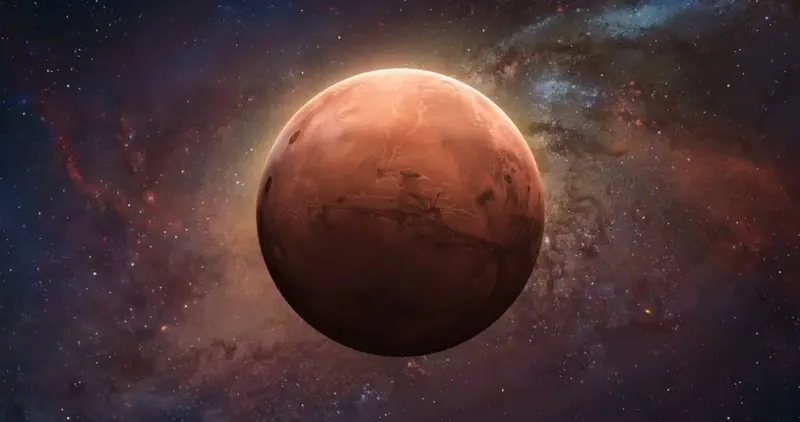In an exciting twist to our understanding of Mars, recent research suggests that the Red Planet may have remained habitable for hundreds of millions of years longer than previously believed. Traditionally, scientists thought that Mars lost its protective magnetic field around 4.1 billion years ago, leaving it vulnerable to harsh cosmic radiation and leading to its current barren state.
Why a Magnetic Field is Crucial for Habitability
A magnetic field is one of the most essential factors in making a planet habitable. Mars’s magnetic field, like Earth’s, served as a protective shield, guarding its atmosphere from being stripped away by solar winds and cosmic radiation. Without this shield, planets become vulnerable, leading to atmospheric loss and exposure to harmful radiation. Earth’s magnetic field has played a critical role in maintaining its life-sustaining conditions, and Mars was no different in its early years.
Harvard scientists now believe that Mars retained this shield for longer than previously thought. By conducting computer simulations and analyzing the magnetic patterns in ancient Martian craters, researchers found signs that Mars might have experienced a magnetic polarity reversal—a process also seen on Earth. This reversal, they propose, could mean that Mars’s magnetic field was active far beyond initial estimations, creating a longer period of stability and protection for any potential microbial life.
New Findings Extend Mars’s Habitability Window
This research is groundbreaking in more ways than one. The study suggests that Mars’s magnetic field persisted around 200 million years longer than initially believed, giving the planet a much wider habitable period. Traditionally, the absence of a magnetic field was thought to have stripped Mars of its atmosphere too quickly for life to establish itself. However, with this extended period, conditions favorable for life—such as liquid water, stable temperatures, and atmospheric protection—could have been present for a significantly longer time.
By examining impact craters on Mars, researchers identified weak magnetic fields that they believe are remnants of a once-active magnetic shield. This extension to Mars’s magnetic history implies that the Red Planet retained essential life-supporting elements—like water and a denser atmosphere—far longer than previously understood. This opens up a new era in our search for ancient life on Mars and expands the timeframe in which life could have theoretically developed.
Mars with and Without a Magnetic Field: A Comparative Look
The difference between Mars with a magnetic field and Mars without one is staggering. During its magnetic era, Mars likely boasted a thicker atmosphere, more stable temperatures, and potentially even liquid water. In this phase, Mars could have been an environment rich with potential for life, possibly even supporting microbial ecosystems in its soil or waters.
Here’s a brief comparison of the planet’s state with and without a magnetic field:
| Characteristic | With Magnetic Field | Without Magnetic Field |
|---|---|---|
| Atmosphere | Dense, protective | Thin, eroded |
| Water | Likely present in liquid form | Scarce, mostly frozen or evaporated |
| Temperature | More stable, potentially warmer | Extreme fluctuations, generally cold |
| Radiation Levels | Lower, shielded | High, exposed |
The loss of this protective shield led to Mars’s gradual transformation into the cold, barren desert we see today. Its atmosphere thinned out, water mostly froze or evaporated, and any chances for life diminished rapidly. Understanding this transformation helps us piece together Mars’s history and gives us clues about the planet’s once-promising potential for life.
What This Means for Mars Exploration
This extended magnetic period on Mars brings new focus to Mars exploration. Missions like NASA’s Perseverance rover, which is currently searching for signs of ancient microbial life, can use this new data to refine their target areas. The knowledge that Mars may have been habitable for hundreds of millions of years longer means that ancient life, if it existed, may have left detectable traces in older and possibly deeper Martian layers.
Future missions can now aim to drill deeper into Mars’s surface, where traces of ancient life may be preserved in protected areas. The 2029 NASA mission OSIRIS-APEX is expected to analyze samples from Apophis, an asteroid that could yield further clues about Mars’s history by understanding solar wind interactions.
Redefining Mars’s Place in Our Search for Extraterrestrial Life
Mars’s extended habitability has broad implications for the search for extraterrestrial life. This revelation places Mars higher on the list of potentially life-supporting bodies within our solar system, on par with moons like Europa and Enceladus, which are also considered prime targets due to their potential for harboring liquid water beneath icy surfaces.
Moreover, the new findings allow scientists to draw parallels between Mars’s evolution and Earth’s. On Earth, a robust magnetic field has shielded life from harsh cosmic conditions. Mars may have shared a similar environment in its early years, with a magnetic field protecting it just long enough for life to begin to form. Even if life did not take hold, Mars’s longer habitable period gives scientists invaluable data about what makes a planet capable of supporting life and how planets might transition from habitable to inhospitable.
The Transformation of Mars: From Potentially Habitable to a Desert Wasteland
The decline of Mars’s magnetic field marked a turning point for the planet. As Mars lost this protection, its atmosphere eroded, water vanished, and the surface became barren and dry. What was once potentially a thriving environment transformed into the harsh landscape we see today.
As NASA continues to plan future Mars missions, understanding this transformation could help us unravel the mysteries of other planets undergoing similar changes. It could also serve as a lesson for Earth, illustrating the importance of magnetic fields and atmospheres in sustaining life. By learning from Mars’s past, we might gain insights into the future of Earth and other planets that share its potential.
Future Prospects: What’s Next for Mars Research?
With Mars’s habitability extended by 200 million years, scientists have renewed excitement about future research. Investigating Martian rock samples, searching for ancient microbial biosignatures, and probing the subsurface for signs of past water are now even more critical. Some of the key areas that will likely gain attention in upcoming research include:
- Martian Rock Samples: Analyzing rock samples for any hints of ancient microbial life. If Mars did support life, it would likely have left evidence in mineral deposits, especially those shielded from surface radiation.
- Subsurface Water Deposits: Investigating regions that may have held water longer, possibly protecting it from the harsh solar winds that stripped Mars’s atmosphere.
- Atmospheric Composition: Studying remaining atmospheric components for clues about the planet’s lost era of stability.
- Innovative Technologies for Detection: Developing advanced tools to detect faint traces of biological activity that may be preserved beneath Mars’s surface.
The significance of these findings goes beyond Mars. It emphasizes the potential for life beyond Earth, even in unlikely environments. The more we discover about Mars’s history, the more our understanding of life’s resilience and adaptability grows, leading to new possibilities in the search for life elsewhere in the universe.
Conclusion
In summary, the discovery that Mars may have been habitable far longer than we previously thought has profound implications. This finding not only reshapes our view of Mars but also broadens our perspective on the potential for life beyond Earth. As we continue exploring Mars and expanding our knowledge of its history, each discovery takes us one step closer to answering whether we are truly alone in the universe. The Red Planet’s story, marked by its rise and fall as a potential cradle for life, may offer the answers we seek in our quest to understand life’s place in the cosmos.
Reference:
Langlais, B., Erwan, T., Houliez, A., & Purucker, M. E. (2019). A new model of the crustal magnetic field of Mars using MGS and MAVEN.

















